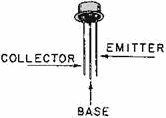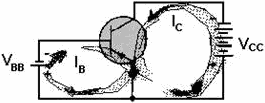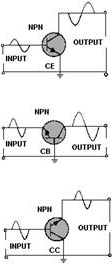Module 7 - Introduction to Solid-State Devices and Power Supplies
Pages i ,
1-1,
1-11,
1-21,
1-31,
1-41,
2-1,
2-11,
2-21,
2-31,
2-41,
2-51,
3-1,
3-11,
3-21,
3-31,
3-41,
3-51,
4-1 to 4-10,
4-11,
4-21,
4-31,
4-41,
4-51, Index

Figure 2-22. - a typical integrated circuit packaging sequence.

Figure 2-23. - Common IC packaging styles.
The preceding information was presented to give you a brief introduction into integrated circuits. If you wish
to pursue this subject further, additional information is available in your ship's or station's library.
2-41
Summary Now that you have completed this chapter, a short review of the more important points covered in the
chapter will follow. This review should refresh your memory of transistors, their theory of operation, and how
they are tested with an ohmmeter. A Transistor is a three or more element solid-state
device that amplifies by controlling the flow of current carriers through its semiconductor materials.

The THREE ELEMENTS of a Transistor are (1) the Emitter, which gives off current
carriers, (2) the Base, which controls the carriers, and (3) the Collector, which collects the carriers.
 The two Basic TYPES of Transistors are the NPN and PNP. The only
difference in symbology between the two transistors is the direction of the arrow on the emitter. If the arrow
points in, it is a PNP transistor and if it points outward, it is an NPN transistor.
2-42

The four Transistor MANUFACTURING PROCESSES are the (1) point contact, (2) grown or
rate-grown junction, (3) alloy or fused junction, and (4) diffused junction.
 2-43
The PROPER BIASING of a Transistor enables the transistor to be used as an amplifier. To
function in this capacity, the emitter-to-base junction of the transistor is forward biased, while the base-to-
collector junction is reverse biased.
 NPN Transistor Operation is basically the action of a relatively small emitter-base
bias voltage controlling a relatively large emitter-to-collector current.
 PNP Transistor Operation is essentially the same as the NPN operation except the
majority current carriers are holes and the bias batteries are reversed.
 Amplification is the process of increasing the strength of a signal.
An Amplifier is the device that provides amplification without appreciably altering the original
signal.
2-44
The Basic Transistor Amplifier amplifies by producing a large change in collector
current for a small change in base current. This action results in voltage amplification because the load resistor
placed in series with the collector reacts to these large changes in collector current which, in turn, results in
large variations in the output voltage.
 The three types of BIAS used to properly bias a transistor are base-current bias (fixed bias),
self-bias, and combination bias. Combination bias is the one most widely used because it improves circuit
stability and at the same time overcomes some of the disadvantages of base-current bias and self-bias.

The Class of Amplifier Operation is determined by the portion of the input signal for
which there is an output.
2-45
There are four classes of amplifier operations: class A, class AB, class B, and class C.
 CUTofF occurs when the base-to-emitter bias prevents current from flowing in the
emitter circuit. For example, in the PNP transistor, if the base becomes positive with respect to the emitter,
holes are repelled at the emitter-base junction. This prevents current from flowing in the collector circuit.
SATURATION
occurs in a PNP transistor when the base becomes so negative, with respect to the emitter, that changes in the
signal are not reflected in collector-current flow. Class a AmplifierS are biased so
that variations in input signal polarities occur within the limits of cutoff and saturation. Biasing an amplifier
in this manner allows collector current to flow during the complete cycle (360 degrees) of the input signal, thus
providing an output which is a replica of the input but 180 degrees out of phase. Class a operated
amplifiers are used as audio- and radio-frequency amplifiers in radio, radar, and sound systems.

Class AB AmplifierS are biased so that collector current is zero (cutoff) for a portion
of one alternation of the input signal. Therefore, collector current will flow for more than 180 degrees but less
than 360 degrees of the input signal. The class AB amplifier is commonly used as a push-pull amplifier to overcome
a side effect of class B operations.
2-46

Class B AmplifierS are biased so that collector current is cut off during one-half of
the input signal. Thus, for a class B operation, collector current will flow for approximately 180 degrees (half)
of the input signal. The class B operated amplifier is used as an audio amplifier and sometimes as the
driver- and power- amplifier stage of transmitters.

Class C AmplifierS are biased so that collector current flows for less than one-half
cycle of the input signal. The class C operated amplifier is used as a radio-frequency amplifier in
transmitters.

Fidelity and Efficiency are two terms used in conjunction with
amplifiers. Fidelity is the faithful reproduction of a signal, while efficiency is the ratio of output signal
power compared to the total input power. The class a amplifier has the highest degree of fidelity, but
the class C amplifier has the highest efficiency. A Transistor Configuration is the
particular way a transistor is connected in a circuit. a transistor may be connected in any one of three different
configurations: common emitter (CE), common base (CB), and common collector (CC).
2-47

The Common-Emitter Configuration (CE) is the most frequently used configuration in
practical amplifier circuits, since it provides good voltage, current, and power gain. The input to the CE is
applied to the base-emitter circuit and the output is taken from the collector-emitter circuit, making the emitter
the element "common" to both input and output. The CE is set apart from the other configurations, because it is
the only configuration that provides a phase reversal between input and output signals.
 The Common-Base Configuration (CB) is mainly used for impedance matching, since it has
a low input resistance and a high output resistance. It also has a current gain of less than 1.
In the CB, the input is applied to the emitter, the output is taken from the collector, and the base is the
element common to both input and output.
2-48

The Common-Collector Configuration (CC) is used as a current driver for impedance
matching and is particularly useful in switching circuits. The CC is also referred to as an emitter-follower and
is equivalent to the electron-tube cathode follower. Both have high input impedance and low output impedance.
In the CC, the input is applied to the base, the output is taken from the emitter, and the collector is the
element common to both input and output.
 Gain is a term used to describe the amplification capabilities of an amplifier. It is
basically a ratio of output to input. The current gain for the three transistor configurations (CB, CE, and CC)
are ALPHA (α), BETA (β), and GAMMA (γ), respectively.

The Transistor Configuration COMPARIsON CHART gives a rundown of the different
properties of the three configurations.
2-49
 Transistor Characteristics are usually presented on specification sheets. These sheets
usually cover the following items: 1. The kind of transistor. 2. The absolute maximum
ratings of the transistor. 3. The typical operating values of the transistor. 4.
Additional engineering/design information.
Transistors ARE IDENTIFIED by a Joint Army-Navy (JAN) designation printed directly on the case of
the transistor. If in doubt about a transistor's markings, always replace a transistor with one having identical
markings, or consult an equipment or transistor manual to ensure that an identical replacement or substitute is used.
..................
2..................
N..................
130..................
A..................
.................. NUMBER of SEMI- CONDUCTOR IDENTIFICATION First
.................. JUNCTIONS...................................................... NUMBER
MODIFICATION .................. (Transistor) TESTING a Transistor to
determine if it is good or bad can be done with an ohmmeter or transistor tester or by the substitution method.
PRECautionS should be taken when working with transistors since they are susceptible to
damage by electrical overloads, heat, humidity, and radiation. Transistor LEAD IDENTIFICATION
plays an important part in transistor maintenance because before a transistor can be tested or replaced, its leads
must be identified. Since there is NO standard method of identifying transistor leads, check some typical lead
identification schemes or a transistor manual before attempting to replace a transistor.
2-50
| - |
Matter, Energy,
and Direct Current |
| - |
Alternating Current and Transformers |
| - |
Circuit Protection, Control, and Measurement |
| - |
Electrical Conductors, Wiring Techniques,
and Schematic Reading |
| - |
Generators and Motors |
| - |
Electronic Emission, Tubes, and Power Supplies |
| - |
Solid-State Devices and Power Supplies |
| - |
Amplifiers |
| - |
Wave-Generation and Wave-Shaping Circuits |
| - |
Wave Propagation, Transmission Lines, and
Antennas |
| - |
Microwave Principles |
| - |
Modulation Principles |
| - |
Introduction to Number Systems and Logic Circuits |
| - |
- Introduction to Microelectronics |
| - |
Principles of Synchros, Servos, and Gyros |
| - |
Introduction to Test Equipment |
| - |
Radio-Frequency Communications Principles |
| - |
Radar Principles |
| - |
The Technician's Handbook, Master Glossary |
| - |
Test Methods and Practices |
| - |
Introduction to Digital Computers |
| - |
Magnetic Recording |
| - |
Introduction to Fiber Optics |
| Note: Navy Electricity and Electronics Training
Series (NEETS) content is U.S. Navy property in the public domain. |
|




























